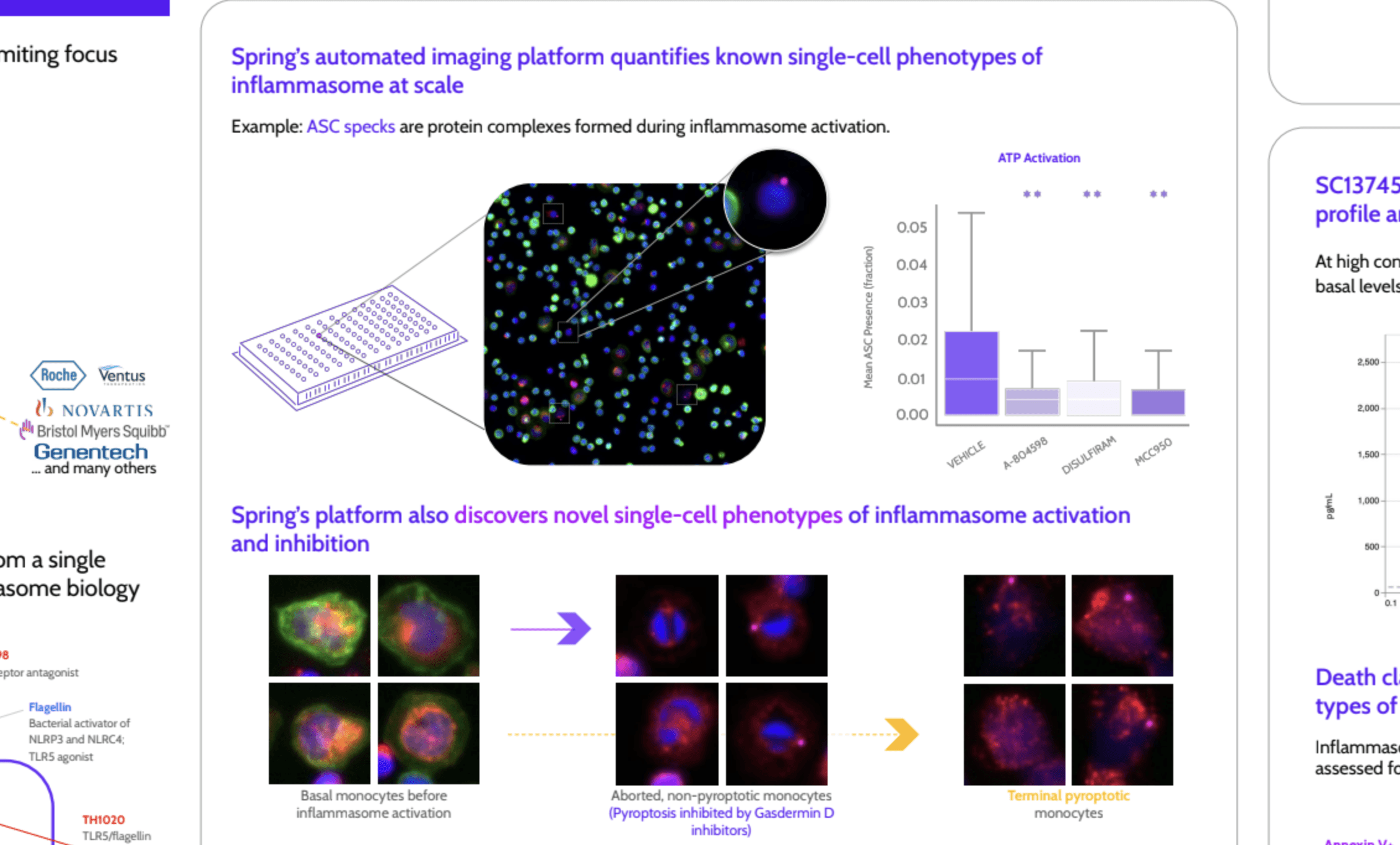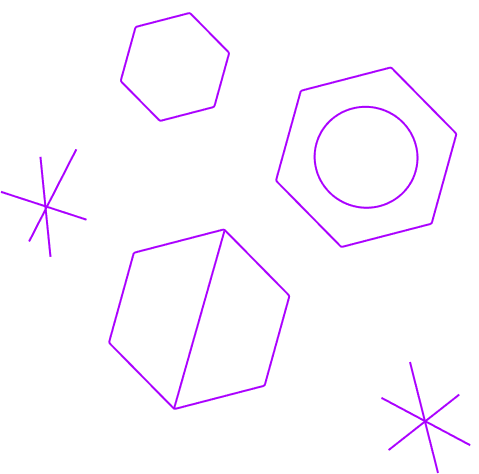Use Case
Identify mechanism of action (MoA)
Uncover previously unknown mechanisms of action and untangle subtle biological distinctions
Identify mechanism of action (MoA)
Uncover previously unknown mechanisms of action and untangle subtle biological distinctions
Identify mechanism of action (MoA)
Uncover previously unknown mechanisms of action and untangle subtle biological distinctions
Identify mechanism of action (MoA)
Uncover previously unknown mechanisms of action and untangle subtle biological distinctions
Extract meaningful, interpretable features from your images
Interpretable, biologically meaningful features surfaced to help your team understand mechanisms of action
Quantify any cellular phenotype you can see
Narrow down MoA's by teaching your own AI model to learn the differences between complex single cell phenotypes
Find novel single-cell biology hiding in your data
Surface known and unknown single-cell phenotypes that point towards both known and novel biological mechanisms
Extract meaningful, interpretable features from your images
Spring's AI technology helps scientists work their way towards interpretability of complex imaging data so you can spend your time interrogating meaningful biology, not writing code and battling finnicky image analysis settings. Narrow down mechanisms of action with a combination of meaningful, interpretable measurements ranging from immune cell populations to metabolism to cell-to-cell interactions to intracellular tracking to mitochondrial networks to actin dynamics to multiple types of cell death quantification to more.

Extract meaningful, interpretable features from your images
Spring's AI technology helps scientists work their way towards interpretability of complex imaging data so you can spend your time interrogating meaningful biology, not writing code and battling finnicky image analysis settings. Narrow down mechanisms of action with a combination of meaningful, interpretable measurements ranging from immune cell populations to metabolism to cell-to-cell interactions to intracellular tracking to mitochondrial networks to actin dynamics to multiple types of cell death quantification to more.

Extract meaningful, interpretable features from your images
Spring's AI technology helps scientists work their way towards interpretability of complex imaging data so you can spend your time interrogating meaningful biology, not writing code and battling finnicky image analysis settings. Narrow down mechanisms of action with a combination of meaningful, interpretable measurements ranging from immune cell populations to metabolism to cell-to-cell interactions to intracellular tracking to mitochondrial networks to actin dynamics to multiple types of cell death quantification to more.

Extract meaningful, interpretable features from your images
Spring's AI technology helps scientists work their way towards interpretability of complex imaging data so you can spend your time interrogating meaningful biology, not writing code and battling finnicky image analysis settings. Narrow down mechanisms of action with a combination of meaningful, interpretable measurements ranging from immune cell populations to metabolism to cell-to-cell interactions to intracellular tracking to mitochondrial networks to actin dynamics to multiple types of cell death quantification to more.

Differentiate pathways by modeling and quantifying even the most subtle phenotypes
Untangle differences between subtle mechanistic pathways by training your own AI models to quantify any phenotype your team can visually see. From mitochondrial networks to localized antigen uptake to kidney-shaped nuclei to "mushroom"-shaped single cells to partially arrested cell death to anything else you can label — quickly model it all and see how these phenotypes change across your experimental conditions.
Differentiate pathways by modeling and quantifying even the most subtle phenotypes
Untangle differences between subtle mechanistic pathways by training your own AI models to quantify any phenotype your team can visually see. From mitochondrial networks to localized antigen uptake to kidney-shaped nuclei to "mushroom"-shaped single cells to partially arrested cell death to anything else you can label — quickly model it all and see how these phenotypes change across your experimental conditions.
Differentiate pathways by modeling and quantifying even the most subtle phenotypes
Untangle differences between subtle mechanistic pathways by training your own AI models to quantify any phenotype your team can visually see. From mitochondrial networks to localized antigen uptake to kidney-shaped nuclei to "mushroom"-shaped single cells to partially arrested cell death to anything else you can label — quickly model it all and see how these phenotypes change across your experimental conditions.
Differentiate pathways by modeling and quantifying even the most subtle phenotypes
Untangle differences between subtle mechanistic pathways by training your own AI models to quantify any phenotype your team can visually see. From mitochondrial networks to localized antigen uptake to kidney-shaped nuclei to "mushroom"-shaped single cells to partially arrested cell death to anything else you can label — quickly model it all and see how these phenotypes change across your experimental conditions.
From unbiased clusters to mechanism of action
Cluster your well- and single-cell phenotypes in an unbiased manner to uncover all sorts of biological mechanisms, known and unknown. These clusters can be colored or filtered by metadata — explore and narrow down which experimental conditions are driving each phenotypic cluster, and what phenotypes are in each cluster, to gain unprecedented insight into mechanism of action.
From unbiased clusters to mechanism of action
Cluster your well- and single-cell phenotypes in an unbiased manner to uncover all sorts of biological mechanisms, known and unknown. These clusters can be colored or filtered by metadata — explore and narrow down which experimental conditions are driving each phenotypic cluster, and what phenotypes are in each cluster, to gain unprecedented insight into mechanism of action.
From unbiased clusters to mechanism of action
Cluster your well- and single-cell phenotypes in an unbiased manner to uncover all sorts of biological mechanisms, known and unknown. These clusters can be colored or filtered by metadata — explore and narrow down which experimental conditions are driving each phenotypic cluster, and what phenotypes are in each cluster, to gain unprecedented insight into mechanism of action.
From unbiased clusters to mechanism of action
Cluster your well- and single-cell phenotypes in an unbiased manner to uncover all sorts of biological mechanisms, known and unknown. These clusters can be colored or filtered by metadata — explore and narrow down which experimental conditions are driving each phenotypic cluster, and what phenotypes are in each cluster, to gain unprecedented insight into mechanism of action.
See it in action
“The Spring platform allows us to spend time thinking about our hypothesis instead of writing code.”
— PRINCIPAL SCIENTIST, BIG PHARMA

“The Spring platform allows us to spend time thinking about our hypothesis instead of writing code.”
— PRINCIPAL SCIENTIST, BIG PHARMA
“The Spring platform allows us to spend time thinking about our hypothesis instead of writing code.”
— PRINCIPAL SCIENTIST, BIG PHARMA
See what happens when scientists use Spring
Ready to get started?
Try out our tools with your existing workflow, or we can create a custom experience for you.
For industry
Spring tools are licensed by pharma, biotechs, startups, and research groups of all kinds.
For academics
We make it easy for academic research groups and non-profits to try Spring's tools.
For educators
Educators are invited to use Spring in the classroom and with their research students.
Ready to get started?
Try out our tools with your existing workflow, or we can create a custom experience for you.
Ready to get started?
Try out our tools with your existing workflow, or we can create a custom experience for you.
Ready to get started?
Try out our tools with your existing workflow, or we can create a custom experience for you.
Ready to get started?
Try out our tools with your existing workflow, or we can create a custom experience for you.
PARTNERSHIPS
Spring's tech is used by a range of partners across biotech, pharma, and academic research. We provide both strategic collaborations and software licensing.
© 2023 Spring Discovery.
All rights reserved.

